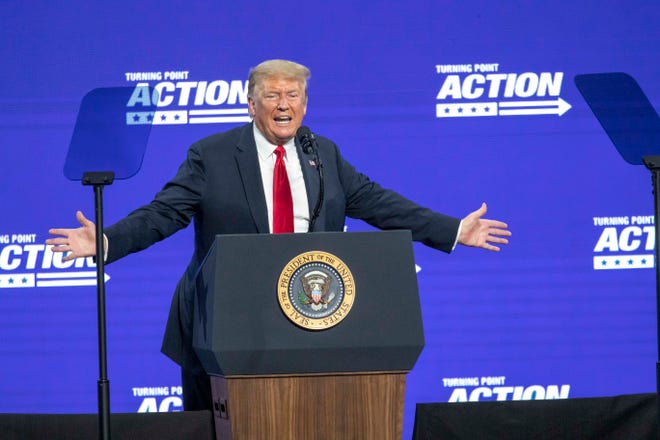More On: Election
Facebook read the private messages of people in the U.S. who had doubts about the 2020 election
Before the November election, DeSantis gets a lot of money from people who gave money to Trump
The Problem with Ballot Harvesting
State Legislatures Cannot Overturn the Results of Presidential Elections
Hillary Clinton Offers Her Opinion On The Presidential Election Of 2024
The Senate’s approval leaves no vacancies on any circuit court. This week the Senate reached a milestone, confirming President Trump’s 200th judge, Cory Wilson of Mississippi, who is now to join the U.S. Court of Appeals for the Fifth Circuit. The number 200 encompasses all life-tenured judges authorized by Article III of the Constitution and does not even include …
The Senate’s approval leaves no vacancies on any circuit court.
This week the Senate reached a milestone, confirming President Trump’s 200th judge, Cory Wilson of Mississippi, who is now to join the U.S. Court of Appeals for the Fifth Circuit. The number 200 encompasses all life-tenured judges authorized by Article III of the Constitution and does not even include additional confirmed judges who serve for limited terms. Wilson is Trump’s 53rd circuit court appointment. As the second-highest courts in the land, circuit courts of appeals are where the vast majority of appeals are resolved.
Trump’s most prominent appointments are two Supreme Court justices, Neil Gorsuch and Brett Kavanaugh, for a total of 55 appellate judges — more than any other president at this point in his presidency, and almost as many as President Obama appointed in eight years. That is a real achievement, and even those impressive numbers do not tell the whole story.
Trump’s appointments and obstacles
Trump’s judicial appointments are constitutionalists who are dedicated to the rule of law. That means interpreting laws according to their text and original meaning, which in turn means deferring to the people’s elected representatives where the Constitution is silent. Litigants across the country can increasingly trust that federal judges will give them a fair shake in court.
We have already seen this in numerous opinions by Trump-appointed appellate judges that are protective of constitutional rights and constitutional structure, which is also essential to our liberty. These judges do not put their fingers on the scale in favor of one side but are willing to see through the fog of challenges like the pandemic and protect rights such as the free exercise of religion when the government targets it for discriminatory treatment.

The 200 confirmations occurred in the face of unprecedented obstacles. Democrats, intent for years on using the courts to impose their own policy agenda, abused one Senate process after another in the effort to prevent the upper chamber from getting its work done. They tried to distort the Senate’s blue slip tradition, a courtesy designed to allow senators from a judicial nominee’s home state time to consider the nomination, into a veto that they would use indiscriminately for the sake of delay.
Democrats also routinely forced cloture votes on judicial nominees, no matter how noncontroversial, in order to draw out the voting process and impose the 30-hour clock that kicked in after cloture was invoked.Cloture votes on nominations were first allowed by Senate rules during the Truman administration, but if we were to add together the sum of all such votes that were taken at this point in every presidency between Truman and Obama, that number would still be less than one-fifth of the number that Trump judicial nominees faced. Democrats also attempted to filibuster Trump’s first Supreme Court nominee.
Republicans pushing against obstacles and leaving no vacancy behind
Senate Majority Leader Mitch McConnell and the two chairmen of the Senate Judiciary Committee who have served since 2017, Chuck Grassley and Lindsey Graham, deserve recognition for their determined leadership in the face of such obstacles. The filibuster, which Democrats had previously abolished for lower courts, was also abolished for the Supreme Court. Circuit nominees were processed by the Judiciary Committee regardless of whether recalcitrant Democratic senators refused to turn in their blue slips. The onerous 30-hour clock that followed cloture motions — a period notorious for the paucity of actual debate on nominations — was reduced to two hours for district judges.
McConnell started this year with the motto “leave no vacancy behind,” and now every circuit court vacancy has been filled. Three of the circuit courts flipped from a majority of Democrat-appointed judges to a Republican-appointed majority, and others are likely in range over the next four years.
In 2016, Trump became the first presidential candidate to pre-release to the public a shortlist of his Supreme Court prospects, a precedent he is now repeating. In just one term, Trump saved America from a court system that would have been dominated by liberals for a generation if Hillary Clinton had won. He knows what is at stake going forward. So does Joe Biden, who did so much to encourage the politicization of the courts as the Judiciary Committee chairman who presided over the Robert Bork and Clarence Thomas nomination travesties.
It is telling that Biden refuses to release his own list just as he increasingly caves to a radicalized Democratic Party whose goal is to have the courts impose legislation under the guise of judicial opinions. Every time that happens, there is one more power taken away from the voters when they go to the polls in future elections to vote for actual legislators. If President Trump has the chance, he will nominate another great justice who believes political power belongs in the hands of the people, not the courts. In this year’s election, the stakes could not be higher.
Writen by Carrie Severino, president of the Judicial Crisis Network.





















